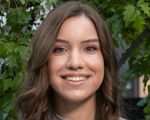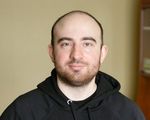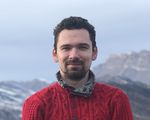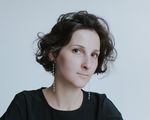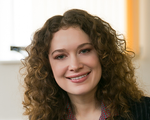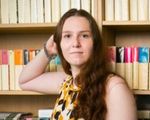About Success Builder
How do you find your place in life? How do you find something to do that both comes naturally to you and makes you happy? The answer is that you have to apply the knowledge you’ve gained from university and from life itself correctly. The Success Builder Project features HSE University graduates who have discovered themselves through an interesting business or an unexpected profession. The protagonists share their experiences and lessons learnt and talk about how they’ve made the most of the opportunities they were given.
To devote one’s time to scientific research does not at all mean to engage in abstract academic reflection. Vasily Minkov, who graduated first from the HSE’s Faculty of Social Sciences and then from its Faculty of Computer Science, conducts research as a bioinformatician at the BostonGene medical company. He even managed to give his musical project a cultural and anthropological focus. In this interview with Success Builder, Mr. Minkov explained how the brain is studied in HSE laboratories, what bioinformatics is and why working in the industry is useful for a scientist.
How did your passion for biology lead you to study at the Faculty of Psychology?
Actually, I had planned since the eighth grade to study biology professionally, so in high school I spent a lot of time preparing for a biology major or medical school. But before entering the university, I suddenly became interested in the humanities as well. I was drawn towards social anthropology and art history. It was a kind of crisis of identity and self-discovery. As a result, I went to study in the Czech Republic for a year, where I became very ill and could not take the exam, and so I returned to Moscow.
Here, I decided to apply to a programme in the humanities. For a long time, I couldn’t decide which one, and when I had already submitted my application to the Faculty of Biology, I ended up at the open house of the HSE Faculty of Psychology where Vasily Klyucharev was speaking. I really liked the fact that I could combine my two interests in the humanities and biology within the framework of psychology. That’s how I ended up at HSE University. I was still searching for myself and wanted to study philosophy as well, because it meant I could study Lacanian psychoanalysis and the French tradition of cultural anthropology—or at least write a thesis under the guidance of a teacher from the School of Philosophy.
The funny thing is that I overcame this notion when I imagined how I would go to the Basmanny District, which was extremely inconvenient. I just had to accept the fact that circumstances were propelling me to do what I had chosen from the very beginning. Then I became interested in the activities of the Laboratory of Cognitive Psychophysiology, where I could work on interesting tasks and meet people with similar interests. On the one hand, they were closely connected with the topic of biological processes; on the other hand, they had an excellent understanding of the philosophical literature on thinking and awareness.
How did lab work lead you to the idea of staying in science?
I wound up in a group of like-minded people and got involved in the laboratory’s projects. I really liked what we did there. However, the projects also required technical knowledge and data skills, which forced me to gain new knowledge and set new goals—by then, it was pointless to stop. The experiments at the lab involved signal processing, and these required programming skills and an understanding of mathematics. I signed up for a data analysis minor, where I learned how to program, and in my free time I improved my knowledge of higher mathematics. I ended up at the Centre for Neuroeconomics and Cognitive Research, in the neuroimaging group, where I came across a project that encouraged creativity and the search for my own ideas.
I liked this freedom, and even my fresh programming skills were put to use pretty quickly: it was necessary to write algorithms for the neuroscience project, so I could put my new interest into practice. Thus, by the end of my second year, I had finally formed an understanding of what I wanted to do, and this led me to the master’s programme. I had a desire to develop my knowledge, so an academic career was attractive. I currently work for a commercial company, but I have the opportunity to work in the applied aspects of science, including data analysis and writing programs for biological research, which require the direct application of my academic skills.
How do coding and engineering skills find application in the neurosciences?
Neuroscience is closely related to the analysis of data received from the brain and from the nervous system in general. These data are signals that need to be analysed, statistics that must be read and interpreted. Data in neuroscience is very abstract, so they need to be converted using special algorithms before you can work with them.
For example, we get a human encephalogram in the form of a bunch of sinusoids, which by themselves cannot be interpreted in any way. From these sinusoids, we need to obtain information indicating with which area and functional state of the brain they are associated. This is where mathematical methods are applied so that, based on the data obtained, we can compare sinusoids with each other and build a connection to the functional states of the brain. So this is where programming comes into play.
With which technologies are the HSE University labs equipped, and what do you find interesting about working with the machines?
When I worked in the laboratory, we were mainly engaged in bioelectrical interfaces and analysed the electrophysiological activity of the brain using the electroencephalogram (EEG), magnetoencephalogram and electrocorticogram (ECOG). I find the ‘brain-computer’ interface particularly interesting. This is when we translate brain signals into a command for a computer.
I worked mainly with encephalographs. Using a special cap, you can read brain activity associated with limb movement and interpret it as a command for an external device, such as a robot.
We did this in a computer simulation, moving objects around in space. These were the main projects we worked on at the Centre for Bioelectrical Interfaces because Alexey Osadchy was my supervisor and he worked mainly with data from magnetoencephalographs and electroencephalographs. The laboratory, as far as I know, also planned to collaborate with the Sklifosovsky Institute, where they are able to take an encephalogram directly from the surface of the brain during operations, making it possible to collect the most accurate data without interference from the skull.
Are these lab projects and the work with these interfaces reflected in your research?
It happens that my bachelor’s degree focused on the method of neural feedback. It is part of a rather broad scientific field devoted to the biofeedback method. I was able to obtain the necessary data for this in the lab. When a person has a disorder, such as epilepsy, we can non-invasively train the brain to suppress the pathological activity. Bioactive feedback is also used to treat attention deficit hyperactivity disorder in children. My work was devoted to the subsection of biofeedback connected with brain activity. In 2017, I even presented my research at Science Battles. I think that I managed to explain what I do very intelligibly.
You managed to publish several articles with Professor Tadamasa Sawada. How has working with him influenced your research interests?
Professor Sawada took a very unusual view of computer vision and machine learning that I found quite interesting. We met in 2014, when machine learning in the neurosciences, and especially in the field of vision, received a strong push to develop. He worked on models of visual perception. We wrote an article in which we reached some interesting conclusions. This experience was extremely useful towards my academic development.
How did you become a bioinformatics specialist after all this? What is this field and what research is being done in it?
Bioinformatics deals with the analysis of biological sequences, nucleic acids, and proteins in order to understand the functions of the human genome. We use various laboratory methods to read DNA, RNA and protein sequences and we try to identify a specific gene that affects the presence of a disease, or lack of digestibility, or neurons in the brain. Biology became an exact science when it began working with such sequences; now it can describe processes that are tied to genetic information in a very precise way.
When I was in the third year of my bachelor's degree, HSE University introduced its master’s programme in bioinformatics. This was of great interest to me for its application of precise methods. In graduate school, I switched to neuroscience and everything related to chemistry and genetics. I ended up in the laboratory of the famous neurobiologist and physiologist Yuri Panchin. He works at the Institute for Information Transmission Problems of the Russian Academy of Sciences that studies how genes determine brain function. We have completed several collaborative projects in sleep physiology and have continued to work since I remained in the lab as a junior researcher.
Because I learned how to work with genomes and immersed myself in bioinformatics, I was able to find a job in the medical field in the industry—at BostonGene where I specialise in the study of lymphoma and the immune system. I had a very short course in immunology during my master’s programme and at this company I have managed to link my knowledge of bioinformatics with that field in greater depth. Basically, in bioinformatics research, it doesn’t matter what kind of genetic data you’re working with. These can be cells of adipose or bone tissue, blood or neurons; you can apply the methods you know to data from every area.
I perform exclusively bioinformatic tasks for the company’s projects and have been working here for three years, analysing the data that I receive from blood cells. In parallel, I conduct research at the Institute of the Russian Academy of Sciences on the physiology of sleep. I am also thinking about getting a PhD from a foreign university, although I really enjoy working for the company.
I am lucky in that, in a commercial environment, I have the opportunity to receive advanced data that also holds great interest for application in academia
Right now I’m working with patient data from clinics that specialize in cancer treatment, and our company has done a lot of work to get access to this data. This will help me a lot when studying for a PhD, where I can do something really significant. My work in the industry can do a lot to advance science with the help of unique data.
You are not only a bioinformatician, but also a researcher of the musical landscape. You have a cool channel on Telegram. What is this project and how does it intersect with your core activities?
At the outset of my studies at HSE University, I was very interested in psychoanalysis and cultural anthropology, a large part of which is our musical heritage. I wanted to turn my passion for music into some kind of product, and two years ago I started doing the World Music Geek project about different cultures of the world and traditional music. The development and change of cultures of different peoples reminds me very much of the development and change of living organisms in the process of evolution.
In biological terms, culture is undergoing a convergent evolution in which musical genres perform applied functions among different peoples—they are used in rituals and in secular or religious events. And they are divergent: we find that in Africa or South Asian culture people pay more attention to rhythm, and in Europe, to harmony. Why are modal components so important in Central Asia while in European culture everything must conform to the laws of harmonic organization?
I would like to create a genetic map of traditional music
It would be great to try to assemble a database of traditional music released by various labels and to analyse its ‘genetic code’ in order to draw conclusions about some unique cultural identity of this or that region. Now, in my free time, which is extremely scarce, I am working on an Internet resource that will bring together geographical, anthropological and musical information. This will make it possible to visually trace the stylistic musical connection characteristic of a certain geographical area.
Unfortunately, few people are involved in the systematisation of traditional music; it is difficult to understand and has no commercial potential. On the other hand, this leaves me completely free in how I pursue my project and I try to find more and more interesting ways in which it resembles human genetic characteristics. Music inspires me a lot, and my findings sometimes help me look at scientific problems from a completely new angle.





